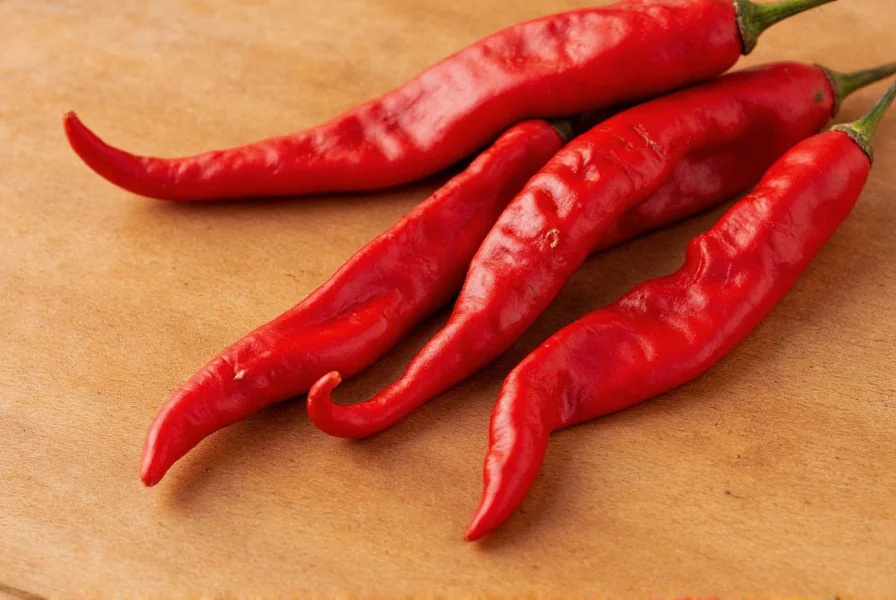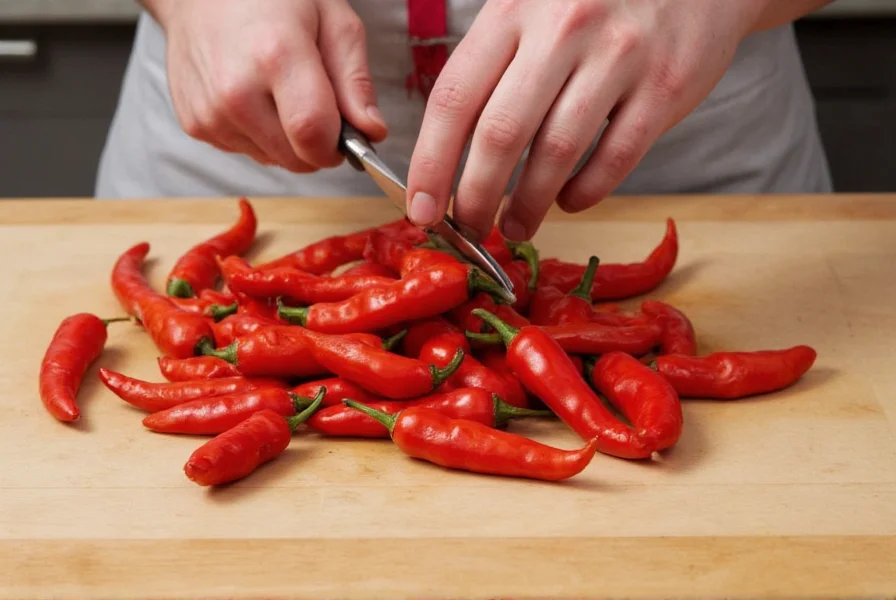The arbol pepper (Capsicum annuum) is a slender, 2-3 inch long chili pepper with a vibrant red color when mature, measuring 15,000-30,000 Scoville Heat Units (SHU). Known for its sharp, nutty flavor with subtle smokiness, this dried Mexican chili pepper delivers intense heat that builds gradually, making it ideal for salsas, sauces, and marinades where controlled spiciness is desired.
Understanding the unique characteristics of arbol peppers helps home cooks and culinary professionals harness their distinctive heat profile. Unlike many chilies that lose complexity when dried, arbol peppers maintain their bright, almost citrusy undertones alongside significant heat. This balance makes them particularly valuable in Mexican cuisine where flavor complexity matters as much as spiciness.
Physical Characteristics and Flavor Profile
Arbol peppers, whose name means "tree" in Spanish, grow upright on the plant resembling small branches. They typically measure 2-3 inches in length with a diameter of about half an inch. When fully mature, they transform from green to a brilliant, almost glossy red. The drying process concentrates their natural flavors while preserving their distinctive shape.
What sets arbol peppers apart is their complex flavor profile. While registering 15,000-30,000 SHU on the Scoville scale (comparable to cayenne but with different flavor notes), they offer more than just heat. The initial taste reveals subtle nutty undertones followed by a clean, sharp burn that builds gradually rather than hitting immediately. This delayed heat progression allows cooks to layer flavors without overwhelming other ingredients.

Arbol Pepper vs Similar Varieties
Understanding how arbol peppers compare to other common chilies helps determine appropriate substitutions and applications. The following comparison highlights key differences:
| Pepper Type | Heat Level (SHU) | Flavor Profile | Common Uses |
|---|---|---|---|
| Arbol | 15,000-30,000 | Sharp, nutty, slightly smoky | Salsas, hot sauces, marinades |
| Cayenne | 30,000-50,000 | Earthy, slightly fruity | Spice blends, powdered seasoning |
| Serrano | 10,000-25,0Normally fresh | Bright, grassy, intense heat | Fresh salsas, guacamole |
| Thai Bird | 50,000-100,000 | Floral, citrusy | Asian cuisine, pickling |
While arbol and cayenne peppers occupy similar heat ranges, their flavor profiles differ significantly. Arbol peppers deliver a cleaner, sharper heat with nutty notes, whereas cayenne offers earthier, slightly fruitier characteristics. This distinction becomes particularly important in applications where the pepper's flavor contributes to the overall taste profile rather than just providing heat.
Culinary Applications and Techniques
Professional chefs value arbol peppers for their versatility in both dried and rehydrated forms. When using dried arbol peppers, proper preparation techniques maximize their flavor potential:
- Dry toasting: Briefly toast whole peppers in a dry skillet over medium heat for 30-60 seconds until fragrant but not burnt. This enhances their nutty characteristics.
- Rehydration: Soak toasted peppers in hot water for 15-20 minutes until pliable. Reserve the soaking liquid for additional flavor dimension in sauces.
- Seed management: For controlled heat levels, remove seeds and white membranes (where capsaicin concentrates) before use.
One professional technique involves creating arbol pepper oil by steeping whole peppers in high-quality olive oil for 2-3 weeks. This infused oil adds subtle heat and flavor to finished dishes without overwhelming other ingredients. The same principle applies to vinegar infusions for pickling applications.

Substitution Guidance
When arbol peppers aren't available, understanding appropriate substitutions prevents recipe failures. The best substitute depends on whether you prioritize matching the heat level or flavor profile:
- For similar heat with different flavor: Cayenne pepper (use 30% less by volume as it's typically hotter)
- For similar flavor with less heat: Dried serrano peppers (soak longer to compensate for thicker walls)
- For fresh applications: A combination of serrano peppers with a pinch of smoked paprika to approximate the nutty/smoky notes
When substituting in recipes calling for whole dried peppers, maintain similar quantities but adjust based on your heat tolerance. For ground applications, start with half the recommended amount and adjust to taste, as grinding increases surface area and perceived heat.
Storage and Preservation
Proper storage maintains arbol peppers' flavor and heat for extended periods. Whole dried peppers stored in airtight containers away from light and moisture retain quality for 1-2 years. For longer preservation:
- Vacuum-seal with oxygen absorbers for 3+ year storage
- Store in the freezer (prevents insect infestation)
- Grind only as needed, as ground peppers lose potency faster
Check stored peppers periodically for signs of moisture or mold. Properly stored dried arbol peppers should remain brittle and snap cleanly when bent. If they become leathery, they've absorbed moisture and should be used immediately or discarded.
Nutritional Considerations
Like other chili peppers, arbol peppers contain capsaicin, the compound responsible for their heat, which has been studied for potential health benefits. They also provide vitamin C, vitamin A, and various antioxidants. A single dried arbol pepper contains minimal calories (approximately 5-7 calories) but delivers significant flavor impact.
When incorporating arbol peppers into your diet, start with small amounts to assess tolerance. The delayed heat response can lead to overconsumption if not careful. Those with sensitive digestive systems may want to remove seeds and membranes completely to reduce capsaicin content while retaining flavor.
Frequently Asked Questions
What is the difference between arbol pepper and cayenne pepper?
While both register similarly on the Scoville scale (arbol: 15,000-30,000 SHU, cayenne: 30,000-50,000 SHU), they differ significantly in flavor profile. Arbol peppers have a sharper, cleaner heat with distinct nutty notes and subtle smokiness, while cayenne offers earthier, slightly fruitier characteristics. Arbol peppers are typically used whole or crushed in Mexican cuisine, whereas cayenne is more commonly found as a fine powder in spice blends.
Can I use fresh arbol peppers instead of dried?
Fresh arbol peppers are rarely available commercially as they're primarily cultivated for drying. If you find fresh ones, they'll be significantly milder than their dried counterparts. To approximate dried arbol flavor, use fresh serrano peppers with a pinch of smoked paprika. Remember that drying concentrates both flavor and heat, so fresh peppers won't deliver the same intensity as dried arbol peppers.
How can I reduce the heat of arbol peppers in a dish?
To reduce arbol pepper heat without losing flavor, remove all seeds and white membranes before use, as these contain the highest concentration of capsaicin. Soaking rehydrated peppers in milk or adding dairy products to the finished dish can also neutralize heat. For immediate relief while cooking, add acidic components like lime juice or vinegar, which help balance perceived spiciness. Remember that arbol pepper heat builds gradually, so allow time between adjustments.
Are arbol peppers the same as bird's eye chilies?
No, arbol peppers and bird's eye chilies (Thai chilies) are different varieties. While both are slender and relatively hot, arbol peppers are longer (2-3 inches) with a more subdued heat (15,000-30,000 SHU) and nutty flavor, whereas bird's eye chilies are shorter (1-2 inches), significantly hotter (50,000-100,000 SHU), and have floral, citrusy notes. Arbol peppers are Mexican in origin, while bird's eye chilies originate from Southeast Asia.
What dishes work best with arbol peppers?
Arbol peppers excel in Mexican salsas (particularly cooked salsas like salsa roja), mole sauces, and adobo marinades. Their clean heat makes them ideal for oil or vinegar infusions. They work particularly well in dishes where you want noticeable heat that doesn't overwhelm other flavors, such as bean dishes, roasted vegetable preparations, and certain meat marinades. Professional chefs often use them in finishing oils for tacos and grilled meats.











 浙公网安备
33010002000092号
浙公网安备
33010002000092号 浙B2-20120091-4
浙B2-20120091-4